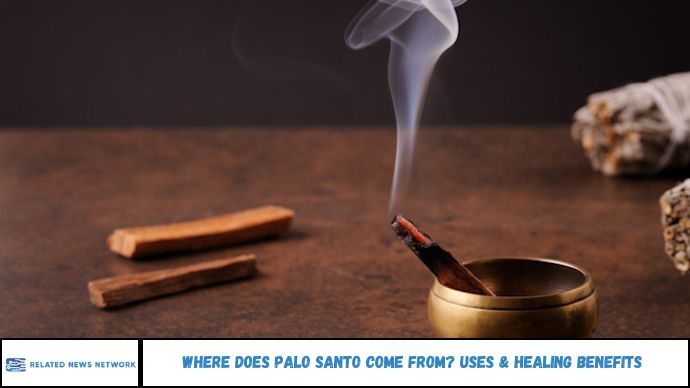Where Does Palo Santo Come From? Uses & Healing Benefits Ever wondered why Palo Santo—a small, fragrant wood stick—has become a staple in yoga studios, spiritual practices, and wellness rituals? Known as “holy wood,” Palo Santo has been used for centuries in traditional ceremonies, but today, it’s also found in essential oils, candles, and even skincare.
Palo Santo, which translates to “holy wood” in Spanish, has rapidly grown in popularity, becoming a staple in both spiritual practices and wellness routines. Valued for its distinctive, aromatic scent and claimed spiritual and medicinal properties, Palo Santo belongs to the same botanical family as frankincense and myrrh. Its traditional use dates back hundreds of years, rooted in the rituals and healing ceremonies of Indigenous South American cultures.
Abstract
Palo Santo is a sacred wood native to South America, traditionally used for spiritual cleansing, energy balancing, and healing. This article explains where it comes from, how it’s used, and the cultural and medicinal significance it holds. Learn about modern uses, sustainability concerns, and how to incorporate it responsibly into your own wellness routine.
What Is Palo Santo?
Palo Santo, meaning “holy wood” in Spanish, is derived from the Bursera graveolens tree, which grows in:
- Peru
- Ecuador
- Venezuela
- Parts of Mexico and Central America
It belongs to the same botanical family as frankincense and myrrh and has been used for centuries by indigenous communities, including the Inca and other Andean cultures, in spiritual ceremonies and folk medicine.
Where Does Palo Santo Come From?
The Palo Santo tree thrives in dry tropical forests and is primarily harvested in Peru and Ecuador. But here’s something most people don’t know:
- The wood must age naturally after the tree dies before it’s harvested—usually for 4–10 years.
- This aging process enhances its aromatic oils, giving Palo Santo its signature sweet, woody scent with hints of mint and citrus.
- Ethical sourcing requires no cutting of live trees—only dead wood should be collected for true sustainability.
Fact: Peru declared Palo Santo a protected species to prevent overharvesting and illegal trade.
Traditional and Spiritual Uses
Palo Santo has deep roots in shamanic rituals and spiritual cleansing:
Common Traditional Uses:
- Burning sticks to clear negative energy or spirits
- Creating smoke baths to purify spaces or people before healing rituals
- Infusions and teas for pain relief, cold symptoms, or digestive issues
Spiritual and Energetic Uses:
- Smudging similar to sage, to restore balance and calm
- Used during meditation and yoga to enhance focus
- Believed to elevate energy and invite positive vibrations
Modern Wellness and Practical Applications
Today, Palo Santo is used not only in spiritual practice but in aromatherapy, beauty, and home goods.
Popular Modern Uses:
- Essential oils in diffusers for relaxation and anxiety relief
- Natural mosquito repellents
- Soaps, body oils, and skincare for its antimicrobial properties
- Scented candles and incense for ambiance and focus
Scientific studies are still limited, but Palo Santo essential oil has shown anti-inflammatory and antifungal properties, according to a 2021 study published in Molecules.
Sustainability and Ethical Concerns
Due to its growing popularity, concerns about overharvesting and illegal trade have increased.
What to Look For:
- Buy from certified, ethical sources
- Look for Palo Santo products labeled as “naturally fallen” wood
- Support companies that work with local communities and reforestation programs
Organizations like SERFOR (Peru’s forestry service) regulate ethical harvest and export practices.
Tip: Avoid vendors who can’t trace the origin of their wood—sustainability matters.
FAQ
1. What tree does Palo Santo come from?
Palo Santo comes from the Bursera graveolens tree, native to South American forests.
2. Is it legal to buy and use Palo Santo?
Yes, but only if it’s ethically sourced from naturally fallen trees and not endangered forests.
3. What is Palo Santo used for spiritually?
It’s used for energy cleansing, grounding, and spiritual protection in rituals and meditation.
4. Can you use Palo Santo every day?
Yes, but moderation is key. Daily use should be intentional and respectful of its cultural origins.
5. Is Palo Santo better than sage?
Both are effective. Sage is more purifying; Palo Santo is more grounding and uplifting in scent.
6. Does Palo Santo have health benefits?
Its essential oil may offer anti-inflammatory, antimicrobial, and stress-reducing effects.
Conclusion
Palo Santo is more than just a trendy fragrance—it’s a sacred tool with deep cultural, spiritual, and healing roots. Whether you use it to clear your space, calm your mind, or connect with tradition, understanding where Palo Santo comes from helps you use it more consciously.
If you choose to bring Palo Santo into your life, do so with intention—and make sure you’re supporting its preservation for generations to come.
Next Step: Look for ethically sourced Palo Santo from verified sellers and explore how it fits into your own wellness journey.









